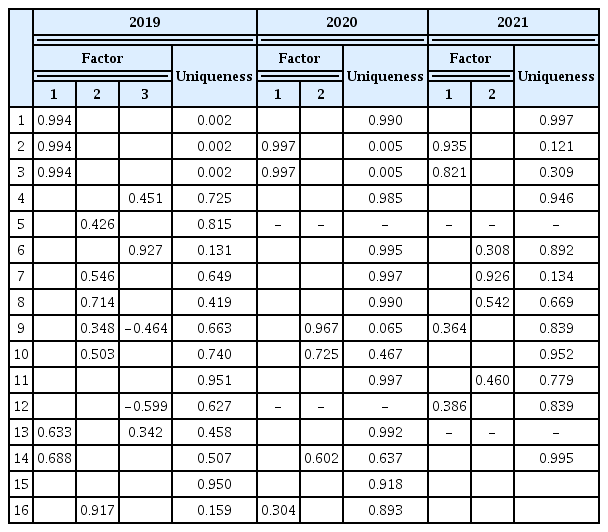References
1. Chae H, Cho E, Kim SK, et al. Analysis on validity and academic competency of mock test for Korean Medicine National Licensing Examination using Item Response Theory. Keimyung Medical Journal 2023;
2. Park SH. Possibilities and Limits of High Stakes Testing in US. Korean Journal of Comparative Education 2010;20:1–21.
3. Eggen TJ, Stobart G. High-stakes testing–value, fairness and consequences. High-Stakes Testing in Education Routledge: 2015. p. 1–6.
5. Kim KS. Introduction and administration of the clinical skill test of the medical licensing examination, republic of Korea (2009). Journal of Educational Evaluation for Health Professions 2010;:7.
6. Han SY, Lee S.-H, Chae H. Developing a best practice framework for clinical competency education in the traditional East-Asian medicine curriculum. BMC Med Educ 2022;22:352. 2022;05. 11. DOI:
https://doi.org/10.1186/s12909-022-03398-4.
7. Shin J, Go Y, Song C, et al. Presentation on research trends and suggestion for further research and education on Objective Structured Clinical Examination and Clinical Performance Examination in Korean Medicine education: Scoping review. Society of Preventive Korean Medicine 2022;26:87–112.
10.25153/SPKOM.2022.26.2.008.
8. Korean Laws Information Center. ACT ON DEVELOPMENT OF E-LEARNING INDUSTRY AND PROMOTION OF UTILIZATION OF E-LEARNING Ministration of Trade, Industry and Engergy. 18358Sejong, Korea: Korean Laws Information Center; 2021.
9. Chae H, Han SY, Yang G, et al. Study on the herbology test items in Korean medicine education using Item Response Theory. Kor J Herbology 2022;37:13–21.
DOI:
https://doi.org/10.6116/kjh.2022.37.2.13.
10. Chae H, Lee SJ, Han c-h, et al. Study on the Academic Competency Assessment of Herbology Test using Rasch Model. J Korean Med 2022;43:27–41.
DOI:
https://doi.org/10.13048/jkm.22017.
12. Kim S, Kim Y. Generalizability Theory 2nd edth ed. Paju: Education Science Publishing; 2016.
13. Nunnally JC, Bernstein IH. Psychometric theory 3 rd edth ed. New York: McGraw-Hill; 1994.
14. Shin S, Kim GS, Song JA, et al. Development of examination objectives based on nursing competency for the Korean Nursing Licensing Examination: a validity study. J Educ Eval Health Prof 2022;19:19. 2022;08. 23. DOI:
https://doi.org/10.3352/jeehp.2022.19.19.
15. Seong T, Kang DJ, Kang E, et al. Introduction to Modern Pedagogy Seoul: Hakjisa; 2018.
16. Lee M-j. Exploring the feasibility of implementing criterion-referenced assessment in Korean medicine education: enhancing comprehension and relevance. J Kor Med Edu 2023;1:10–14.
DOI:
https://doi.org/10.23215/JKME.PUB.1.1.10.
18. Navas-Ferrer C, Urcola-Pardo F, Subirón-Valera AB, et al. Validity and reliability of objective structured clinical evaluation in nursing. Clinical Simulation in Nursing 2017;13:531–543.
19. Hur HK, Park SM, Kim KK, et al. Evaluation of Lasater judgment rubric to measure nursing student’ performance of emergency management simulation of hypoglycemia. Journal of Korean Critical Care Nursing 2012;5:15–27.
20. Kim J, Cho L.-R. Analysis of error source in subjective evaluation on patient dentist interaction: Application of Generalizability Theory. The Journal of the Korean Dental Association 2019;57:448–455.
21. Lee SY, Lm SJ, Yune SJ, et al. Assessment of Medical Students in Clinical Clerkships. Korean Medical Education Review 2013;15:120–124.
22. Rim MK, Ahn D.-S, Hwang IH, et al. Validation study to establish a cutoff for the national health personnel licensing examination 2014. Korea Health Personnel Licensing Examination Institute.
23. Ahn S, Choi S. Proposal for a Cut Score for the Physics Ability Test: Comparison between the Modified Angoff, Bookmark, and IDM Methods. New Physics: Sae Mulli 2018;68:599–610.
DOI:
http://dx.doi.org/10.3938/NPSM.68.599.
24. Schoonheim-Klein M, Muijtjens A, Habets L, et al. Who will pass the dental OSCE? Comparison of the Angoff and the borderline regression standard setting methods. European Journal of Dental Education 2009;13:162–171.
DOI:
https://doi.org/10.1111/j.1600-0579.2008.00568.x.
25. Pell G, Fuller R, Homer M, et al. How to measure the quality of the OSCE: A review of metrics – AMEE guide no. 49. Medical Teacher 2010;32:802–811.
10.3109/0142159X.2010.507716.
26. Downing SM. Validity: on meaningful interpretation of assessment data. Med Educ 2003;37:830–837.
10.1046/j.1365-2923.2003.01594.x.
27. Harden RM, Lilley P, Patricio M. The Definitive Guide to the OSCE: The Objective Structured Clinical Examination as a performance assessment Elsevier Health Sciences; 2015.
28. Patrício MF, Julião M, Fareleira F, et al. Is the OSCE a feasible tool to assess competencies in undergraduate medical education? Medical teacher 2013;35:503–514.
29. Ghouri A, Boachie C, McDowall S, et al. Gaining an advantage by sitting an OSCE after your peers: a retrospective study. Medical Teacher 2018;40:1136–1142.
30. Iyer A, Dovedi V. Is there such a thing as a fair OSCE? Medical Teacher 2018;40:1192–1192.







